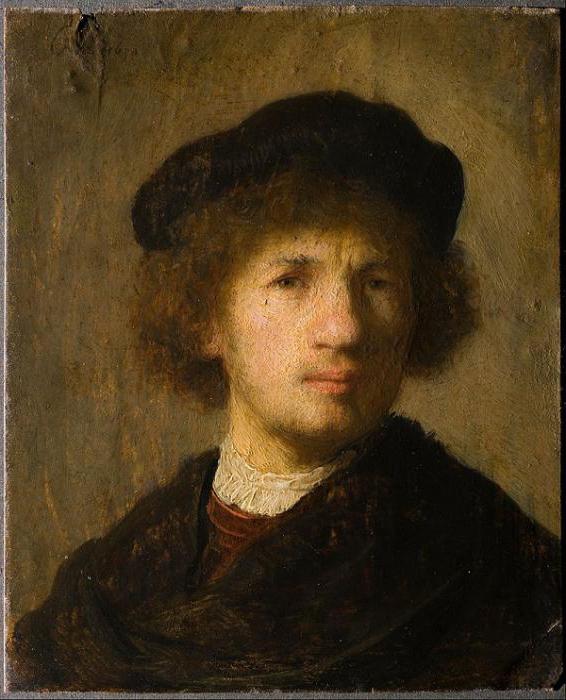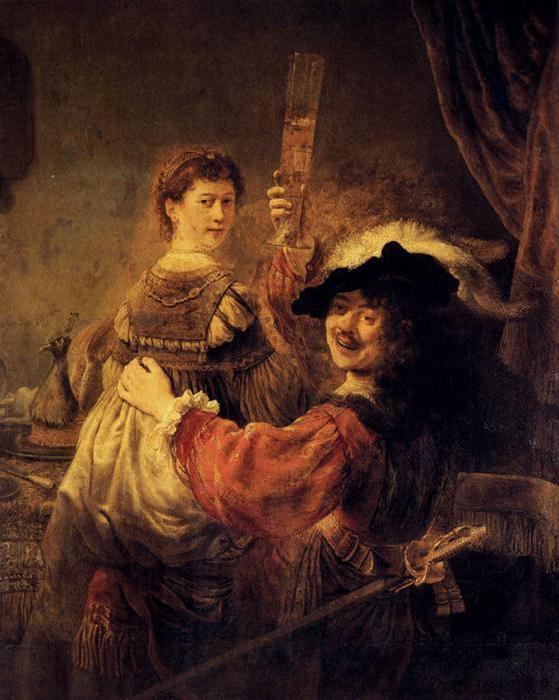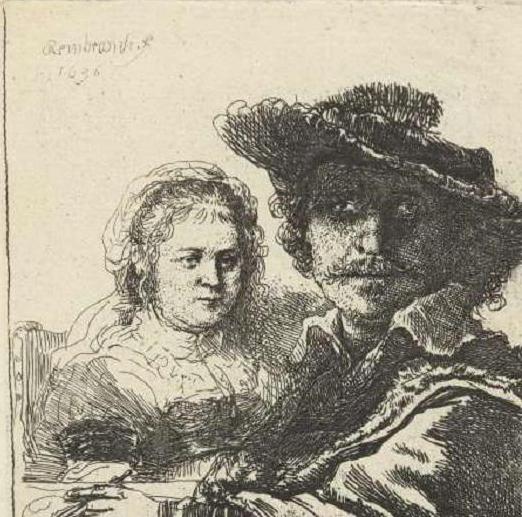At about the same time, in the middle of the 17th century, the ancient flourishing Flanders gave birth to the art of two of the greatest painters - Rubens and Rembrandt.
Biography and self-portraits of Rembrandt
Rembrandt van Rijn was just the son of a miller. He was born on July 15, 1606. By this time, the mill was working at full strength, and his father’s affairs were surprisingly good. Therefore, he was able to educate his fourth son. At first it was a Latin school, and then a university in Leiden. But the boy tirelessly painted and wanted to study painting. By 1628, he became a true artist. One of the first pencil self-portraits represents a very young chubby young man with artistically disheveled hair, burning eyes. Here is young Rembrandt, a self-portrait.
In 1630, he was already a mature man. Before us appears full of desire to create, a true master Rembrandt. Self-portrait captures all these changes. He already has a student Gerard Dow, later a very famous artist. These years are a fruitful period for the artist. Everything around him becomes his model. He is working "for himself" so far, but by 1630 he is already beginning to receive orders. But still Rembrandt writes a self portrait
a young man - himself. I must say that the mirror had a very big impact on the composition and on the ability to look at the mistakes made. And then, of course, eliminate them.
Versatility and Endless Diligence
Throughout his difficult life, changing from prosperity to poverty and oblivion, he will write about six hundred paintings, make about two thousand (!) Drawings and three hundred etchings. One of the master's brilliant paintings on a mythological theme is Danae, which is on display at the Hermitage. It was restored by our restorers after it was doused with acid and cut with a knife. Now she again pleases visitors with her lyricism and warm golden color. “Feast at Esther” on the biblical story is complicated by its deep psychology. The picture tells about the suddenly revealed betrayal. With difficulty choosing words, Esther speaks to him about king Assur. The king only nervously crumpled a handkerchief in his hands, barely restraining his feelings. In the corner, in the shadow, the traitor Aman lurked. The color of the picture itself, shimmering with all shades of cinnabar and gold, shows how confused the story of Esther was. "The Return of the Prodigal Son" is another of the pinnacles of Rembrandt's work. The meaning of the biblical parable is in the forgiveness of errors, realized and redeemed by years of suffering and wanderings. Returning to my father’s home to an understanding father, finding a warm home, all fit on the canvas.

Amsterdam
At this time, since 1631, Rembrandt has been living and working in Amsterdam. If there are not enough orders, then the artist writes to the elderly. And Rembrandt doesn’t forget about his favorite genre - a self-portrait. Here he is a mature man, in a soft beret on his head, carefully and directly looking at us. Looking into himself, the artist better recognizes the person in general, for we share certain common features — love, mercy, suffering, anger, resentment, betrayal, courage, perseverance, confusion.
Wedding
In 1634, the artist marries Saskia van Jupenborch. She is the daughter of a famous lawyer, and Rembrandt, in addition to personal happiness, has material luck and many orders.

Such is the rather brief period of the artist’s happiness and contentment. Rembrandt will enjoy them for only seven years. “Self-portrait with Saskia on her lap” is the apotheosis of his worldly well-being. It also contains the artist’s well-being, expressed in precious draperies, a peacock on a table covered with a patterned tablecloth, beautiful fashionable velvet expensive clothes, the brilliance of a high-raised glass, and the tender affection of a young wife. She half turned to the viewer and calmly looks at us with dark eyes. The hair is chosen with an elegant mesh, hanging earrings in the ears. And the artist, smiling and holding a young woman with his hand, exudes happiness. Noble, brownish-red tones were chosen, but a golden radiance emanates from Saskia, in which her husband, just a little in the shade, just bathes. Everything is shrouded in airspace. By composition, it is a stable isosceles triangle. Also, everything is stable in the world of the creator. But first, a pencil sketch was made, completely unlike the finished work. This is a very light, airy drawing, full of wavy running lines, such characteristic for the master. Instantly captures the nature of Rembrandt. Self portrait with Saskia depicted face to face. In the foreground is the artist, and behind him is a little chubby little wife with carelessly curled hair on her forehead and around the oval of her face, so tender and sweet.

Just a perfect child, a person who enjoys communicating with him, who must, though his favorite work, but tirelessly earn a living. They look homely. The artist's turn-down collar freely opens his neck. On the head - the beloved takes. Many years later, Rembrant will write a self-portrait with Saskia, who has long been gone. He is still the same brave, but next to him is a sweet old woman with whom he could pass the last years. And she retained those features of the child that you want to care for. Her calm eyes contain the memory of the past, and wrinkles - only that life should leave both on the face and on the heart. It is amazing how a person carried the image of his beloved, not forgotten man through his whole life.
After the death of Saskia
She died in 1642 and involuntarily took everything with her. Their children died, only Titus remained. The artist did not enter into a new marriage, although his daughter was born from a relationship with the servant Gendrikie Yagers. And he became interested in collecting. There was so much money left that I had to move to a hotel.
Portraits of Rembrandt
During his life, he wrote about 90 self-portraits. What made him so closely monitor his changes? Apparently, he illustrated his biography with them. Self-portraits of Rembrandt - the life story of the artist. He followed the dynamics of his changes. His portraits are scattered throughout museums around the world.
In 1634, he seemed to be studying himself. What will he come to in life. He has already met his only one and is considering how to make their life worthy and successful. He cannot even imagine what awaits him. He is dressed in furs, velvet and beloved beret.
Year 1640. The happy period still lasts. In the portrait, the artist is quite confident in himself and in the stability of life. A rich outfit, velvet camisole with satin inserts, a thin white shirt with lace and complete calmness only emphasize this.
1652 year. In this portrait, he proudly looks at himself, impoverished, in simple clothes with a hole in his shoulder.
The dark gamut, where light falls only on the face that he wants to highlight, emphasize the severity of the artist. However, a slight mockery plays on his lips - he, like Solomon, knew that everything passes.
1661st. This time he portrayed himself with all the attributes of an artist. Light pouring from a height in the background and deep shadows below are characteristic of the master of chiaroscuro. There is controversy about the curve line behind the artist's back to this day, but art historians have not come to a single conclusion. The master made a riddle for everyone.
1665 year. Rembrandt has already prepared to declare bankruptcy. He calmly looks at impending old age in poverty.
Last years
In 1656, Rembrant transferred his property to his son Titus and declared himself bankrupt. Having moved to the Jewish quarter, I did not quit working. For the most part, he painted portraits of his son. But in 1668 the son dies. It was a hard blow. However, in 1669, the artist created his masterpiece "The Return of the Prodigal Son." In 1669, Rembrandt's last self-portrait was painted. Rembrandt van Rijn ended this creative and earthly life.
Rembrandt, rejected by contemporaries, had a very powerful influence on the development of world art by members of the St. Luke Guild. Painters have studied and continue to learn from his paintings.